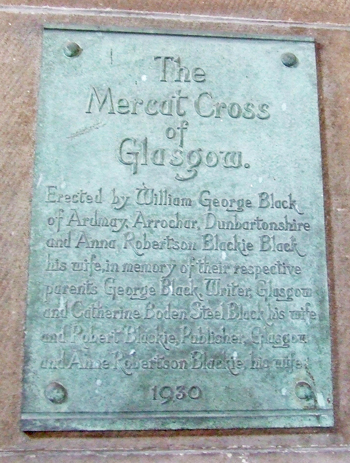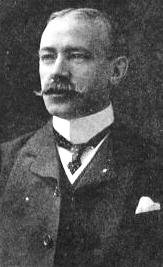ONE of Glasgow’s best known landmarks is the Mercat Cross in the south east corner of the Merchant City – and it was the gift of an Arrochar couple.
William G.Black, CBE, LLD, FSA, JP, who was senior partner in a firm of city solicitors and was Deacon of the Trades House of Glasgow in 1916-17, presented the Cross in 1930 to replace a similar one which had been removed in 1659.
It was designed by Edith Burnet Hughes in a medieval Scots style, shows a rampant unicorn supporting a shield, and stands on a small octagonal pedestal.
The plaque records: ‘The Mercat Cross of Glasgow. Erected by William George Black of Ardmay, Arrochar, Dunbartonshire, and Anna Robertson Blackie Black, his wife, in memory of their respective parents, George Black, Writer, Glasgow, and Catherine Boden Steel Black, his wife, and Robert Blackie, Publisher, Glasgow, and Anne Robertson Black, his wife.”
The Blackie publishing family of course have strong Helensburgh connections, with the Charles Rennie Mackintosh mansion Hill House having been commissioned by Walter Blackie, another director of the firm, who moved into it in 1904.
Born in the city on December 23 1857 but originally from Abington, Lanarkshire, and with Huguenot blood in his veins through the marriage of an ancestor, Mr Black (pictured below) had a distinguished legal career and was also an antiquary and politician.
He was educated at Glasgow Academy, the Albany Academy, and Glasgow University, winning prizes at them all — including for a university essay on the influence of the Renaissance on European literature. In 1884 he became a partner in his father’s firm of Black, Honeyman & Monteath.
He had many interests, contributing to the Glasgow Herald on legal and archaeological topics and to various magazines. In 1878 a paper he wrote on curative charms and spells, entitled ‘Folk Medicine’, was read to members of the British Archaelogical Association, and two years later he was elected joint honorary secretary of Glasgow Archaeological Society.
At the request of the Folklore Society, of which he was one of the founders, he wrote a book on the same subj ect which was published in 1883. Its reception was flattering both at home and abroad, and it was translated into Spanish. He also wrote about the derivation of the name Glasgow, as well as a legal textbook.
ect which was published in 1883. Its reception was flattering both at home and abroad, and it was translated into Spanish. He also wrote about the derivation of the name Glasgow, as well as a legal textbook.
Two years later he acted as joint agent for the Hillhead and Kelvinside Annexation Bill, and as Glasgow secretary for the Edinburgh International Exhibition of 1886, when he was presented to Queen Victoria.
He took an active part in opposing Mr Gladstone’s Home Rule Bill, both as secretary of the Liberal Unionists of the Central Division and as election agent for Vary Campbell in the College Division.
In 1886, in with Mrs Parker Smith, he formed the Women’s Liberal Unionist Association, and he was a vice-president of the West of Scotland Liberal Unionist Association.
He contested the South Division of Aberdeen against the Right Hon James Bryce at the General Election of 1906, and subsequently went on an eight-month trip round the world. He also fought the Elgin Burghs and West Islington seat in 1910.
 For many years he enjoyed in visiting Heligoland, where a cosmopolitan group of friends gathered each summer. His book on ‘Heligoland and the Islands of the North Sea’ is considered the finest description in English of the Frisian people and their legends.
For many years he enjoyed in visiting Heligoland, where a cosmopolitan group of friends gathered each summer. His book on ‘Heligoland and the Islands of the North Sea’ is considered the finest description in English of the Frisian people and their legends.
On the death of his uncle in 1867 he had become owner of the estate of Annathill, and as a Commissioner of Supply for Lanarkshire his interest in the complicated state of local government of that time led him to contribute a paper on the subject to the Law Magazine and Review.
He also succeeded his father as Clerk to the Heritors of Govan, and the problems encountered in that office led to him writing ‘Parochial Ecclesiastical Law of Scotland’, and his reputation for knowledge of this area of law led to his appearance in many sheriff courts in cases relating to manses and churches.
He was a trustee and a member of the executive of the Navy League and chairman of the Glasgow and West of Scotland branch. His First World War work, for which he was made CBE, was especially concerned with Voluntary Aid Detachment committees, disabled officers, and the post-war training of officers.
His many other activities included being a governor of Baillie’s Institution, and a member of council of the Regality Club and of the Master Court of the Weavers Incorporation, and vice-chairman of St Mungo’s College and chairman of the Ophthalmic Institution of Glasgow.
He married Anna Blackie in 1899, but they did not have any children. She died in 1920, and he passed away on December 21 1932, two days before his birthday